|
1. History of the Ecumenical Patriarchate 1830-1923
The period of the history of the Ecumenical Patriarchate which lasts from the end of the Greek War of Independence(1830) until the Asia Minor Catastrophe (1922-1923), is characterized by an internal change: the validation of the text of the General Regulations (1860), which abolished the administrative system of the gerontism and established the participation of lay members in the election of the Ecumenical Patriarch. From the middle of the 18th century, and to a certain degree as a result of the upgrade of the Phanariot class, an aristocracy of the permanent members of the Holy Council (Gerontes-Elders)1 managed to limit and in a great degree to control the competence of the Patriarch.
The 19th century, especially the years after 1830, is characterized by continuous efforts to control the ecclesiastic and political activities of this clericalist aristocracy (Gerontes), given the annihilation and reestablishment of the analogous secular aristocracy (Phanariots). Before the validation of the General Regulations, in the period 1830-1860, 12 patriarchal elections took place, in which 9 different prelates alternated on the position of the Ecumenical Patriarch. After the validation of the General Regulations, and during the period 1860-1923 (double in duration from the previous one), there were 14 elections, in which 12 different prelates assumed the office. In the second period the only patriarchs which were elected for a second time were Ioakeim II and Ioakeim III. The former, spiritual “stature” of the first, was a strong personality which decisively determined the developments of this period and mainly symbolized the contradictions of the Patriarchal institution in an era of disintegration of the Orthodox ecumenical ideology and prevalence of the ideology of nationalism.
2. The Patriarchate and the Tanzimat reforms
The period of the history of the Ecumenical Patriarchate from 1830 until 1860 could be considered a transitional one. As we have already noted, elements of the pervious period survive through procedures of transformation, such as, for example, the function of the Holy Council of the Elders and the collaboration of its members with powerful seculars. The former, however, no longer come from the great families of the Phanariots which had prevailed before the Greek War of Independence, mainly through the control of the thrones of the Pricipalities of the Danube. These families, after the outbreak of the Revolution, were politically distained, financially devastated and the greatest majority of their members abandoned Constantinople. In the position of the families, however, new dynasties emerged, concentrated around powerful personalities of Neo-Phanariots (as cleverly named by Manuil Gedeon): Stefanos Bogoridis, of Bulgarian origin, Nikolaos Aristarchis, of Armenian origin, and Ioannis Psycharis, of Greek origin (from Chios, which was destroyed and had lost all its privileges). This ethnic composition of the political elite of the Neophanariots must be considered accidental, since the Greek Revolution of 1821 had deteriorated the terms under which the rum millet was treated by the Ottoman authorities.
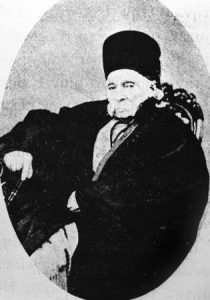 Georgios Afthonidis, Great Secretary of the Patriarchate of Constantinople Meanwhile, the period 1830-1860 coincides more or less with the beginning of the great reformations in the Ottoman state, known as the Tanzimat reformations.2 The reformative spirit in the Patriarchate was expressed with the demand for the institutionalization of the entrance of the seculars in its administration. The first attempt to materialize such a solution took place just before the beginning of the Tanzimat, with the rise of Konstantios I (1830-1834) to the patriarchal throne. Ideological expresser of this tension was the “great secretary” of the Patriarchate Georgios Afthonidis. Afthonidis had proposed the introduction of the lay element to the administration of the Church, the creation of a mixed commission of priests and seculars as well as the payment of the Patriarch’s salary from the Common Treasury. This first attempt will be followed by two more (1843-1847), equally unsuccessful. The situation, however, after the end of the Crimean War and the political marginalization of the Russian influence inside the Patriarchate was utterly changed.
The last period of the life of the Ecumenical Patriarchate under Ottoman authority and after the validation of the General Regulations (from 1860 until 1923) is divided in its turn into four sub-periods/phases:
We can say that the first phase lasts from 1860 until the rise of Ioakeim II to the Patriarchal throne in 1878. The Hatt-i Humayun of 1856 clearly regulated the reorganization of the millet institution. Lay and clerical representatives of the Rum Millet (this practically meant the Greek and Bulgarian representatives) gathered in the Patriarchate in the years 1858-1860. The “National Assembly”, as it became known in the Patriarchate’s history, through great conflicts, abolished Gerontismos, whereas it also compiled a constitutional text, the “General Regulations” (later known as “National Regulations”), according to which the Patriarchate was administrated until the establishment of the Turkish Republic by Mustafa Kemal (1923). The basic characteristic of this text was that it regulated the participation of laity in the Patriarchate’s administration, as well as in the election of the Patriarch. Through the procedures of strengthening the secular element and the decrease of the power of the old “Gerontes” metropolitans came also the strengthening of the responsibilities of the centralized authority of the Ecumenical Patriarch too. Great patriarchs of the 19th century, such as Gregorios VI (1835-1840, 1867-1871), Anthimos VI (1845-1848, 1853-1855, 1871-1873), Ioakeim II (1860-1863, 1873-1878) and mostly Ioakeim III (1878-1884, 1901-1912), gave a new meaning to the notion of the Patriarch – nation leader (Millet Başı).
The importance of the validation of the General Regulations in a political level was the creation of a permanent field of political intervention within the Ecumenical Patriarchate which allowed for a firm intervention of representatives of the cycles of the Neo-Phanariots and of the rising social strata (merchants and bankers) in the administration of the “material issues” of the Patriarchate. The creation of the Continuous National Mixed Council, the simultaneous abolition of Gerontism and the creation of a new Holy Synod in which the role of the provincial prelates was upgraded, created a new balance between the dominant centres of patriarchal life. Meanwhile, the reformers’ party drastically limited the role of the craft guilds in the election of the Patriarch as well as in the administration of the Patriarchate. Consequently, although the participation and the interventions of the laity in the administration of the ecclesiastic issues were not at all unknown inside the Patriarchate, the General Regulations introduced a quality difference in the character of this participation: the element of the general representation of the population of the Greek Orthodox community of Constantinople (but not of the provinces too): the members of the Mixed Council did not come automatically from the circle of the “elders”, as it happened before, but emerged from electoral procedures in the local parishes of Constantinople. Of course this procedure of political intermediation of the community’s “interests” was in a great degree controlled by powerful families of Neo-Phanariots or bourgeois.
The reform movement which followed the legal equality declarations of the Ηatti Ηümayun in the years 1858-1860 was aimed at the abolition of Gerontism and the establishment of the participation of lay members in the Patriarchate’s administration. But behind this declared target there were two basic parameters of the promotion of the reforms: a) the abolition of the supports of the Russian external policy within the Ecumenical Patriarchate (in other words the marginalization of Nikolaos Aristarchis and his allies) and b) the overturning of the interrelations in favour of the Neophanariots families which were friendly to the west and supported the reformations in the Ottoman state (those were gathered mainly around Stefanos Bogoridis and secondly around Ioannis Psycharis).
The dependence relations which developed amongst members of the higher clergy and powerful representatives of the Neo-Phanariots and of the bourgeois circles must be carefully examined. In reality, in this level there was a continuity concerning what was happening in the period before the General Regulations. The three most important protagonists, high-ranking prelates who became patriarchs during the whole period we are examining, maintained close relations with the same circles of powerful lay members.3
The development of these personified relationships, although it did take place in the environment of promotion of the modernization of the Ottoman Empire, and thus was “charged” in a different political way than the analogous relations between the Phanariots and the higher clergy in earlier times, revealed also the limits of the reforms pursued.
3. The Patriarchate and the independent Orthodox Churches: the problem of the “ethno-racialism”
Apart from the issue of the Tanzimat reforms, during this second phase the Ecumenical Patriarchate was found facing the Bulgarian issue. Already from the beginning of the 19th century the Patriarchate was challenged with a new phenomenon, nationalism, which directly threatened the imperial ecumenicity with which the Patriarchate identified itself. In this century of the promotion and establishment of nationalism mainly in the countries of the central, east and south-east Europe, the secession of new nation-states from the Ottoman Empire and the subsequent foundation of nationalized independent Orthodox Churches occurred. The division of the Orthodox flock of the Patriarchate resulted in the final recognition of these ecclesiastic organizations, something which however marked the limitation of the influence but also a grave financial damage for the Great Church.
In a peculiar way the dance of seccessions was inaugurated by the Church of Greece, which was formed in 1833 and was finally recognized by the Patriarchate with the “Volume” (tomos) of 1850. The emergence of the Bulgarian national movement would follow, along with the promotion by the Bulgarian nationalists of the demand for the creation of an independent Bulgarian Church, although an independent state did not yet exist. The recognition of the Bulgarian Exarchate happened with a firman of February 1870, and was followed by the subsequent denunciation of its supporters as schismatic by the Local Synod held in Constantinople in September 1872; this triggered a long political and military antagonism between Greeks and Bulgarians over the control of Macedonia, but also the official validation of a procedure which had started already from the middle of the 19th century: the internal division of the united Orthodox millet (Rum millet), as it was regulated within the Ottoman Empire, into national sub-groups. The Orthodox ecumenicity which represented ideologically the Ecumenical Patriarchate of Constantinople during the whole life time of the Byzantine and later of the Ottoman Empire had suffered a great blow. The equally divisional acts and the publication of Synodic Volumes which validated the independence of the Serbian (1879) and of the Rumanian Church (1885) completed the procedure of the rupture of the Orthodox world of the Balkans, which for more than 1,000 years had lived united inside an imperial environment.
Of course amongst these adventures the Bulgarian issue was probably the most important, mostly because it endangered not just the imaginary community of the Orthodox world, but also the political unity of the Rum millet within the Ottoman Empire. The standard demands of the Bulgarian national movement, as they were formulated from the beginning of the 1840’s, included the election of Bulgarian metropolitans in the provinces which had a Bulgarian population, the replacement of the Greek language in the Holy Mass by the ecclesiastic Slavic (Slavonic) language, the creation of schools in which the Bulgarian language would be taught, outside the control of the Patriarchate. The National Assembly of 1858-1860 gave the opportunity to the Bulgarian nationalists (due to the small representation of the Bulgarian element) to add to these demands the demand for the compilation of a new Holy Synod and of a Continuous National Mixed Council based on the principle of equal representation: half of the members of the Holy Synod and half of the lay members of the Continuous Mixed Council had to be of Bulgarian origin.
The Patriarchate refused to satisfy these demands, organizing its arguments (with the important contribution of intellectuals such as Eustathios Kleovoulos) against the principle of the “ethno-racialism”, which inspired, according to the Patriarchate, the actions of the Bulgarian side. It sustained that it could not cede ecclesiastic autonomy or independence if there was no political annexation from the empire, as happened in the case of the Greeks and the Serbians. This stance was denounced by the Bulgarian side as a policy which favoured the positions of Greek nationalism.
The Patriarchate of course wished to avoid the secession of provinces, which would result in the loss of tax revenues, but in an ideological level it realized that the time of the national movements foresaw the end of the Ecumenicity of the Orthodoxy, as the former was materialized in the framework of the empire. This was the reason that various patriarchs in the decade 1860-1870 suggested several plans for resolving the Bulgarian issue, plans which however failed to appease the aggressive demands of the Bulgarian nationalists. But the failure of the “moderate” confrontation of the Bulgarian demands was caused by internal political antagonisms too.
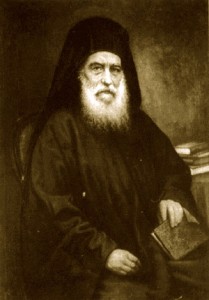 Patriarch Joachim II of Constantinople In 1863 the patriarch Ioakeim II, a man favoured by the bankers, is dethroned because of the way he handled the issue of the confiscation of the lands of the monasteries in Moldova and Wallachia by the prince Alexandru Ioan Cuza. The loss of control by the Patriarchate led the two bankers and the wider circle of bourgeois they represented to follow a harsh policy concerning the Bulgarian issue4 as a means of pressure to patriarchs such as Gregorios VI and Anthimos VI which were elected with an agenda to follow an appeasing policy. Thus the circle of the bankers, although in reality they belonged to the category of the supporters of the “Greco-Ottoman coalition”, often moved towards positions of radical and nationalistic character, resulting into practically pushing things towards the Schism. In February 1870, as already mentioned, the Porte will publish a firman decree according to which the existence of a Bulgarian Exarchate was recognized. This act will lead to the resignation of the patriarch Gregorios (1871) who insisted that the issue should be resolved in an Ecumenical Synod, but will also force the next patriarch Anthimos to call for a Local Synod in September 1872, which condemned the supporters of the Exarchate as schismatic based on the ideological foundation of the condemnation of the “heresy” of “ethno-racialism”.
However, Anthimos’ retreats did not manage to keep him on the patriarchal throne: the bankers this time using the issue of the revising of the General Regulations as a means of pressure managed to dethrone him and to bring back patriarch Ioakeim II (October 1873).
Ioakeim’s reelection confirmed the hegemony of the circle of the bankers,5 which was reproduced with the election of Ioakeim III in 1878, after Ioakeim II’s death. The “pan-Orthodox” politic of these two patriarchs (and thus pro-Russian), as well as Georgios Zarifis’ plan in 1878 to create a unified Greek-Ottoman Empire following the model of Austro-Hungary, showed that this circle was far from abandoning the defense of the imperial-ecumenical model. However, it became clear that the attenuating of the results of the Schism required an opening of the Patriarchate towards Russia, whereas on the other hand the endeavor of the Greek-Ottoman coexistence was based on the argument of the repulse of the Slavic threat. The contradictions of the political choices between this circle of bankers and the prelates who represented it inside the Patriarchate were particularly obvious in the work of its most important representative in the field of culture: Manuel Gedeon.
4. The internal division: Ioakeimists against Antiioakeimists
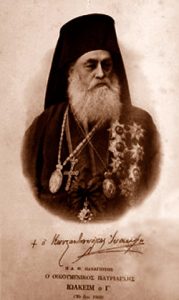 Patriarch Joachim III of Constantinople The first service period of the patriarch Ioakeim III between the years 1878 and 1883/4 marks the beginning of the second phase, which will last until his reelection in 1901. We could sustain that this phase is characterized by a harsh collision between the Ioakimists and the Antiioakeimists. Ioakeim in 1883/4 will be forced to resign from the patriarchal throne, due to complications caused by the first phase of the Privilege Issue. His stance concerning the Privilege Issue, but also concerning the policy of the Greek state, will divide the world of the Patriarchate, priests and seculars, into his fanatic supporters and his fierce enemies. The confrontation between Ioakeimists and Antiioakeimists marked the end of the 19th century and prepared the beginning of the 20th. In this confrontation mostly older divisions of different groups inside the Patriarchate were expressed. The actual, however, issue considered the difference of the strategy proposed by Ioakeim concerning the future of the Orthodox populations in the Ottoman Empire and the way this future was organized on behalf of the national centre and was expressed by the foreign policy mainly of the ambitious Charilaos Trikoupis. More specifically, Ioakeim III enjoyed the political support of the Zarifis family,6 whereas amongst his political opponents Stavros Voutiras, editor of the newspaper of Constantinople Neologos, dominated. Also a great part of the higher Orthodox clergy had turned against him, led by the metropolitan of Herakleia Germanos, later to become patriarch Germanos V.
The Greek embassy and its supporters in Constantinople will manage to prevent Ioakeim III from returning to the throne for 17 whole years, supporting candidates of the Antiioakeimistic party in the patriarchal elections. Thus his return to the patriarchal throne marked also the completion of a great inner conflict of the Patriarchate.
We could say that for the Ecumenical Patriarchate the 20th century practically starts on 25th May 1901 with the reelection of this strong personality on the patriarchal throne of Constantinople. And along with that the third phase of the period examined starts, which will last until Ioakeim’s death in 1912.
The reelection of Ioakeim III was dictated by the new political conditions.7 The direct political heritage the 19th century left for the 20th century considering the survival of the Greek Orthodox populations in the territories of the Ottoman Empire was of course the consequences of the war of 1897, the activation of Slavic-speaking partisan groups in Macedonia, but also two major ecclesiastic crises: the Antioch question, with the election for the first time in 1899 of an Arab-speaking patriarch, and the election of a new archbishop in Cyprus in 1900. Thus, the problems of the new patriarch during his second duty were already very acute.
One of the first actions of Ioakeim III was the publication of a patriarch and a synodic circular in 1902, with which he invited the other Orthodox Churches (and mainly the Russian one) to participate in a dialogue with the Vatican aiming in achieving a consensus (agreement) between the Christian Churches. This move, apart from the fact that it sought to confirm the ecumenist orientations of the Patriarchate in a period of intense ethnic confrontations, mainly in the region of Macedonia, was a belated answer to the circular of the pope Leo XIII in 1894, with which the former invited the Orthodox Christians to unite with the Catholic Church. Meanwhile, Ioakeim III strengthened the relations between the Patriarchate and other non-Orthodox Churches, such as the Anglicans, the Old Catholics e.t.c. Nevertheless, whereas he had prepared the list of the 12 basic issues of inter-Orthodox and inter-Christian discussion, the organization of the Local Synod of Constantinople was not made possible due to the stable rejection of the Sublime Porte to give the appropriate permission.
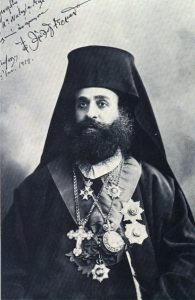 Metropolitan Germanos Karavaggelis However, the outbreak of the Ilinden revolt in 1903 and the beginning of the Macedonian Struggle (1904-1908), with the military conformation of partisan groups of Greeks and Bulgarians, had agitated the political situation and the Ecumenical Patriarchate tried to protect its Orthodox flock in this vital from every aspect geographical area. In the higher ranks of the Orthodox clergy a new generation of priests had already appeared, which was less and less inspired by the ecumenist visions of the previous centuries. On the contrary its actions were based on the logic of the correlation of the national interests and the Orthodox Christian identity (that was the basic reason that the confrontation over Macedonia took the character of a confrontation not of Greeks against Bulgarians but of patriarchists against exarchists/schismatics). Examples of such prelates were Germanos Karavangelis8 and Chrysostomos Kalafatis.9 The intense activity of this circle of prelates would cause many problems to the Patriarchate, which will suffer great political pressures from the side of the Sublime Porte to limit it. A result of these pressures was the so-called Metropolitan issue (1903-1908), i.e. the denunciation of many of these metropolitans as elements which plotted against the Ottoman legality. Karavangelis’ transfer to the diocese of Amaseia and the similar transfer of Kalafatis to the diocese of Smyrna were Ioakeim’s choices for the soothing of this crisis.
In general Ioakeim III, in his effort to balance between his ecumenist visions and the actual needs enforced by the toughening of the stance of Bulgarian nationalism (persecutions of the Greek populations from cities of Eastern Rumelia and of the zone of the Black Sea), finally came into conflict with the majority of the prelates of the Holy Synod10 who pressed him for a more “national” ecclesiastic policy. Meanwhile, however, he had consolidated his supports amongst the lay members of the Continuous National Mixed Council, whereas he successfully faced the pressures on behalf of the Ottoman government. Nevertheless, things changed dramatically in 1908, with the Young Turks’ Revolution. The policy of the new regime led to the actual reappearance of the Privilege issue with much harsher terms than in the crisis’ of 1883/1884 and 1891. These changes were probably sensed by Ioakeim when in March 1908 he assented and published a volume ceding the pastorship of the Greek Orthodox communities of the Diaspora to the Church of Greece.
Some of the new entries in the agenda of the movement of the Young Turks were the abolition of the right of the Christian Orthodox not to enlist in the Ottoman army by paying a military tax, the abolition of the educational duties of the Patriarchate concerning the compilation of study programs for the Greek Orthodox schools in the empire, the abolition of the right of the spiritual courts of the Orthodox to judge civil trials etc., all that in a perspective of putting an end to the ethnic particularities of the old millets of the empire.
Ioakeim III had managed during the first decade of the 20th century to improve the financial condition of the Patriarchate, to found an orphanage for girls on the island of Proti and an orphanage of boys on the island of Pringipos, to found the School of Languages and Trade, to complete the construction of the hospitals of Baloukli and much more. However, he had managed once again to become the target of the attacks of other members of the Holy Synod, due to the fact he did not invite the metropolitan of Chalkedon Germanos (ex-metropolitan of Herakleia), who was his great opponent and the leader of the Antiioakeimist party, as a member of the Synod of 1910-1911. Eventually the confrontation of the two men ended soon and was followed by a short period of collaboration, which had as a reasonable consequence that the succession on the patriarchal throne was already determined.
Indeed Ioakeim III died after a short disease on 13th November 1912, just a few days after the outbreak of the 1st Balkan War. The semiotics of his funeral, through its magnificence, reveals the importance of his person and the work he completed for the interests of the Greek Orthodox populations of the Ottoman Empire in the passage from the 19th to the 20th century and in the same time the great respect he enjoyed on behalf of the Ottoman authority as well as the rest of the great Orthodox powers.
5. The Patriarchate as an extension of the national centre
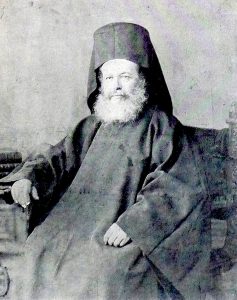 Patriarch Germanos V of Constantinople The death of Ioakeim III marks the beginning of the fourth and last phase of the historical period we examine. His successor, as we already noted, was his great opponent, the metropolitan of Chalkedon Germanos (Georgios Kavakopoulos), who ascended to the patriarchal throne as Germanos V. His election took place on 28th January 1913 and his patriarchate lasted until 12th October 1918. Thus Germanos was the patriarch during the years which were critical for the fate of the Ottoman Empire, from the Balkan Wars until the end of World War I, when the empire found itself defeated on the side of the Central Empires. If Ioakeim III enjoyed the political support of the Zarifis family, Germanos enjoyed the similar support of the Stafanovik family. He had also convinced Pavlos Stefanovik to undertake the total reconstruction of the building of the Theological School of Chalki (1896).
Germanos was elected as a patriarch at the age of 73. From the patriarchal election of 1887 his name was constantly deleted from the electoral catalogues sent by the Patriarchate to Porte (according to what was dictated in the text of the General Regulations), possibly because as the leader of the Antiioakeimist party was considered to be closer to the choices of the Greek foreign policy. During his patriarchate he worked against the spirit and the norm of the General Regulations,11 the Holy Council condemned the heresy of onomatodoxy of the Russian monks of Mount Athos (1913), but also recognized the reestablishment of the Patriarchate of Moscow (1917).
The Balkan Wars (1912-1913) triggered the beginning of a series of migrations and exchanges of populations in the Balkans. Thus the greatest political problem which Germanos was called to solve was the issue of the obligatory transportation of populations enforced by the strategy of evacuation of the coasts of western Asia Minor by the Greek and the Armenian populations. The patriarch Germanos V, old and ill, could not resist to the basic directions of the politics of the Young Turks. There were petitions of the Patriarchate towards the Great Porte, but without any results, whereas Germanos had turned to the Greek state in order to make another petition (without any result again) towards the Porte with the mitigation of Germany (obviously supported by the good relations of King Constantine I with the Germans). However, the evolution of the war and the departure of the ambassadors of the Entente from Constantinople made the possibilities of the diplomatic maneuvers of the Patriarchate difficult. The ineffectiveness of the policy of the patriarch caused the reaction of the majority of the members of the Holy Synod and of the Mixed Council. Germanos in a desperate move dismissed 6 prelates of the Synod and replaced them with others. This change however in the composition of the Holy Synod had no actual result: the patriarch found against him a coalition of Neo-Phanariot families (such as for example Stefanos Karatheodoris) and of nationalist prelates (such as the metropolitans of Ainos Ioakeim, of Amaseia Germanos Karavangelis and of Smyrna Chrysostomos Kalafatis).
The refugee problem was the one which constituted the social foundation of this political reaction. Thus, when the future of the empire was already predetermined, the opposition against him took explosive dimensions resulting into his resignation on 12th October 1918, as we mentioned earlier. It is characteristic that in the same month the metropolitan of Ainos Ioakeim, who gathered around him the opposition of the prelates of the council and of the members of the Mixed Council against Germanos, was the one set in charge of the “Patriarchal Central Commission for the aid of the resettled Greek populations”.
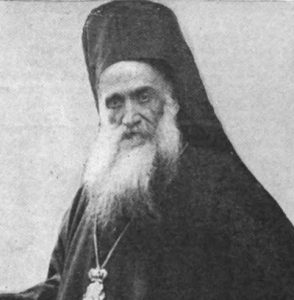 Metropolitan Dorotheos of Prusa, Locum Tenens of the Ecumenical Patriarchate Nevertheless, Germanos’ resign led to a long (three years long) vacancy of the ecumenical throne (but not necessarily of lack of leadership too) until the ascent of Meletios IV to the patriarchal throne in November 1921. During the next two years which followed Germanos’ resignation, the locus tenens of the ecumenical throne, the metropolitan of Prousa Dorotheos, became a powerful personality in the Patriarchate. Of course the main factor responsible for the delay of the patriarchal election was the Greek government, but the delay is mainly explained by the fact that, according to the situation before the war which was determined by the text of the General Regulations, the election had to be validated by the sultan. The Patriarchate, as well as the Greek government, would like to avoid such a possibility, since the issue of the territorial extension of the Greek kingdom against the defeated empire was still open. Of course Athens very quickly (April 1919) revealed her intention for electing Meletios Metaxakis in the position of the patriarch, a person known for his Venizelist feelings and who was also elected as the metropolitan of Athens in February 1918. On the other hand the Porte, being practically in a regime of captivity after the occupation of Constantinople by the allied troops, was no longer in any position to impose the authority of the General Regulations which foresaw the time period of two months for the completion of the election procedure.
The signing of the Sevres treaty (28/10-8-1920) and the proclamation of elections by Venizelos on 1st November 1920 transferred the issue of the election of a patriarch after November. But the defeat of Venizelos in these elections changed the correlations between Athens and Constantinople concerning the issue of the patriarchal election. The apparent political influence of the Venizelists in the former, mainly through the activities of the “Amyna” (Defense) organization, and the fears of the two collective bodies of the Ecumenical Patriarchate that the new royalist government in Greece would not follow the same politic with the previous one concerning the continuation of war brought things to a certain dead end.
Athens oriented in bringing back to the patriarchal throne the resigned patriarch Germanos V, in order to avoid the possibility to see Metaxakis becoming patriarch. With a royal decree he was forced to leave Athens, although he maintained his office as the metropolitan of the city. Metaxakis soon left for America (for a second time in his turbulent career), where he worked for the organization of the Orthodox archbishopric of North and South America, whereas he also founded the seminars of St Athanasios in October 1921. Meanwhile, the death of Germanos V, in December 1920, and the decision of the government of Dimitrios Gounaris to continue the war (March 1921) gave some hopes for a reconciliation between Athens and Constantinople. But the sudden death of the locus tenens Dorotheos on 6th March in London gave the pretext for the prolongation of the vacancy of the ecumenical throne for about 9 more months. The body of Dorotheos was transported and buried in the cemetery of Balukli in Constantinople, opening the way for the election of a new patriarch. But the election did not take place immediately. It is interesting that his successor in the seat of the locus tenens, the metropolitan of Caesarea Nikolaos, took initiatives in order to put the Venizelist officers of the “Amyna” under the control of the royalist Greek government –something which caused the reaction of the British.
Meanwhile the hierarchy of the ecumenical throne took the permission from the Gounaris government and called a conference with 40 prelates in Adrianople (Edirne). On 29th May 1921 this council compiled a referendum to the new locus tenens with two basic points: the delay of the patriarchal election and the demand for the whole hierarchy but also of the lay representatives from every province of the ecumenical throne to be allowed to participate to the election, whenever this was to happen. This was practically an indirect acceptance of the political directive for the prolongation of the locus tenens situation by the royalist government since its decision to bring Germanos V back could not be materialized.
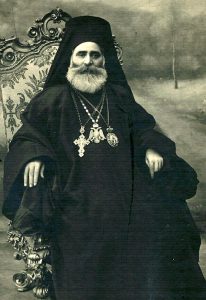 Patriarch Meletios II of Constantinople Eventually the two bodies of the Patriarchate were gathered on 1st October 1921 and decided to elect a patriarch. But when on 25th November the so-called election assembly began its sessions, the majority of the members of the Holy Synod12 absented of the procedure invoking the small participation of prelates to the assembly.13 In reality, the majority of the Holy Synod agreed with the royalist national centre which wanted to avoid the election of Metaxakis, but the minority and the presence of officers of the “Amyna” in the Patriarchate led things towards the opposite direction. The electoral assembly finally proceeded in compiling a three-member list of candidates (triprosopo) containing the names of the metropolitans of Caesarea Nikolaos, of Athens Meletios and of Amaseia Germanos. In the final vote Meletios Metaxakis became the new Ecumenical Patriarch as Meletios IV, with a majority of 16 votes, whereas the two other candidates took one vote each. For the first time a metropolitan of Athens assumed the patriarchic throne of Constantinople: the “Megali Idea” prevailed in the Patriarchate in the same moment its political annihilation in the battlefield was about to take place.
Meanwhile the seven metropolitans of the Synod, with the support of Athens, called a meeting of the hierarchy in Thessalonica, on 16th-22nd December 1921, which decided not to recognize what took place in Constantinople’s electoral assembly, considering it irregular, whereas it also sent a telegram to Metaxakis ordering him to remain in America.
Metaxakis however arrived to Constantinople on 24th January 1922, where he was declared new Ecumenical Patriarch. Metaxakis’ election however caused the reaction of the government of Constantinople, which considered it illegal from the moment Meletios did not have Ottoman citizenship. Nevertheless, the same stance of rejection was kept also by the (royalist) government of Athens for obvious reasons. Meletios was supported by the Venizelists of “Ethniki Amyna” and became a permanent source of trouble for the regime of Constantine. The influence of the government of Athens on the seven members of the Synod of Constantinople (i.e. the majority, since the body of the prelates had twelve members), which questioned the regularity of this election, made the confrontation even more acute. The Synod of the Church of Greece (22nd-29th December 1921) proceeded in dismissing Meletios “from the high office of the prelate”, apparently due to the irregularity of the election, but also because of his activity in America, where he found refuge just after his dismissal from the position of the archbishop, with the pretext he was about to reorganize the local Orthodox Church. The government validated the Synod’s decision with the royal decree of 25th January 1922. This decision, whose irregularity was invoked by the Patriarchate, was of course the answer of King Constantine to the “insubordination” showed by the protagonists of Metaxakis’ election in Constantinople.
To answer this move the Holy Synod issued a decision (1st March 1922) which revoked an older decision (of 1908 under Ioakeim III) with which it placed the Orthodox independent archbishoprics and dioceses of Europe and America under the control of the Greek Independent Church. With this decision the control over these ecclesiastic seats returned to the Ecumenical Patriarchate. Of course only a kind of tragic irony could justify the overthrow of a “nationalistic” decision of a traditionally “ecumenist” Patriarch such as Ioakeim III, by a declared nationalist, such as Meletios. But the harshness of the conflict between monarchists and Venizelists practically demolished ecumenism, which was consolidated as the dominant ideology of the Patriarchate of Constantinople already from the 19th century, promoting a model of nationalization for the Church, compatible to the Great Idea visions of the 20th century. Ecumenism, as it was represented by circles of prelates and around patriarchs such as Gregorios VI, Ioakeim II and Ioakeim III, was an effort to embrace and to adapt the basic nationalistic arguments through the framework of the hegemonic ideology of the Ottomanism (and later Pan-Islamism). The three years 1919-1922 showed that in a great part its incompatibility with the political extensions of the Modern Greek state was directly analogous to its weakness to reproduce this hegemonic discours, without identifying itself in a certain degree with a version of the Modern Greek nationalism. The alliance of the seven Synod prelates, inheritors of this “ecumenical spirit” of the 19th century, with the supporters of Constantine of “Old Greece” showed the limits of the defense of the imperial past.
The course of things after the Asia Minor Catastrophe in the summer of 1922 was predetermined: in reality the time for the collapse of the Great Idea had come either in its Venizelist either in its royalist version. The distrust of the national centre towards the nation-leading church of Constantinople and the fear of the former that collaboration with the latter was very possible to bring the restoration of Venizelism in the national centre of Greece led to the firm stance of Constantinople to face the national issue with a movement which would create an autonomous Asia Minor to a dead end.
In the verge of these two eras Meletios IV remained on the patriarchal throne. Plastiras’ movement on 11th/24th September 1922, the loss of Eastern Thrace and the subsequent victory of the Kemalists in Turkey did not bring his immediate dismissal from the patriarchal throne. And the basic reason for this was that he was placed under the protection of the allied forces, and mainly of the English embassy. The need for the existence of a recognized Ecumenical Patriarch during the negotiations between the two national states (which in our case would result in the signing of the Lausanne Convention) led the Holy Synod to recognize Meletios as a patriarch. However, it was natural that Meletios was considered one of the most dangerous representatives of the Modern Greek nationalism by the Kemalist regime; this is why in the Lausanne negotiations a demand for his dismissal was expressed. This demand was sent to Eleftherios Venizelos by Ismet Inönü, leader of the Turkish delegation. The demand was accepted by Venizelos, who in his turn asked the patriarch to resign. After all the priority of the Greek foreign policy in that moment was to keep the seat of the Ecumenical Patriarchate at Fanari and not to save certain persons, especially since Meletios had expressed his view that the seat of the Patriarchate should be transferred from Constantinople to the Mount Athos or even to Thessalonica. The Patriarch according to him would become a simple archbishop, if his flock would be limited in the number of 200,000 people.
The increasing pressure from the side of Venizelos finally led to the prevailing of the view of the Greek Ministry of Foreign Affairs. Indeed, Meletios, to facilitate the pacification amongst the two sides, on 10th July 1923, fourteen days before the signing of the treaty, left Constantinople for Mount Athos with the permission of the Patriarchate’s two bodies. From there, after the signing of the treaty, he sent his resignation from the position of the Ecumenical Patriarchate on 20th September 1923. The collapse of the Ottoman Empire and the simultaneous limitation of Hellenism in the “national centre” had led to a new era the institution of the Ecumenical Patriarchate too.
|







Thank you for this excellent historical site. A real treasure trove. Regarding the death of Metropolitan Dorotheus of Prousa noted in this essay, I have heard rumours that he died in the arms of the Archbishop of Canterbury, Randall Davidson, just as Metr. Dorotheus was placing the panagia on Abp Davidson. I have not found any reasonably reliable evidence/witness testimony substantiating this claim. Do you know anything about this rumour and how credible it is? Thank you.
Thanks for your kind words. No, I have not heard about Metropolitan Dorotheos dying in the arms of the Archbishop of Canterbury.